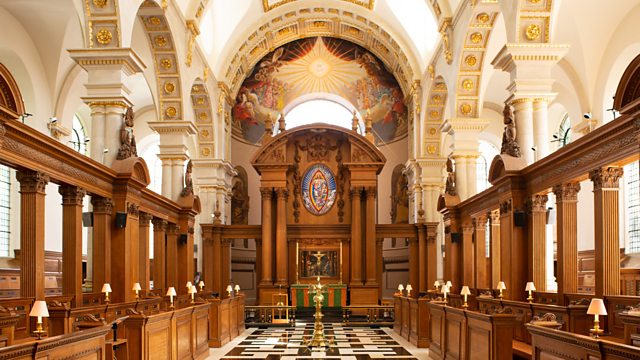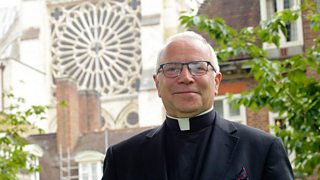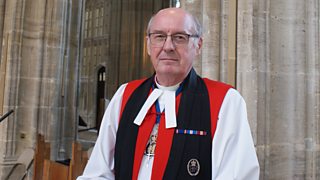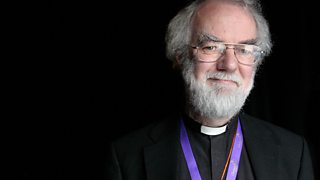
Wren 300
The Bishop of London leads a service marking the 300th anniversary of the death of one of the most highly acclaimed English architects in history, Sir Christopher Wren.
The Bishop of London, Hon Dame Sarah Mullally, leads a service marking the 300th anniversary of the death of Sir Christopher Wren, one of the most highly acclaimed English architects in history. Along with their cultural and historic significance, Wren’s churches offer a place of peace, reflection, creativity and connection, where the bigger questions of life can be explored.
Today’s Sunday Worship visits some of Wren’s churches, exploring their wide-ranging mission and ministry today, as centres of worship, community, culture and social outreach. Art historian Neil MacGregor explores the way in which Wren’s churches not only achieve beauty, but provide different sorts of spaces for diverse congregations. Wren was rebuilding not just churches, but communities after the catastrophic divisions of the Civil War, as well as the destruction of the Great Fire. He explores the notion in Ephesians of citizens as saints, and the need for diversity in the new expanding, ever more international city of the time, and reflects on the need today to provide spaces where citizens of different backgrounds and faiths can engage together with questions of the divine.
Music comes from the Chapel of the Old Royal Naval College in Greenwich, one of Wren’s masterpieces.
Producer: Andrew Earis
Last on
More episodes
Previous
Script
+Sarah Mullally
Good morning. I’m Sarah Mullally,
Bishop of London, and I’m standing overlooking St Paul’s Cathedral in the heart
of London. It was designed and built by Sir Christopher Wren and completed in
1710. This year we celebrate the extraordinary and prolific career of one of
the most highly acclaimed English architects in history, on the 300th
anniversary of his death.
Music
O praise God in his his holiness
– John Weldon
Sung by the Old Royal Naval
College Trinity Laban Chapel Choir, directed by Ralph Allwood
+Sarah Mullally
Wren’s epitaph
in St Paul’s Cathedral, written by his son, says.
‘…Christopher
Wren lived for over 90 years, not for himself but for the public good.�� Reader, if you seek a monument, look around.’��
His churches which have survived are integral to the life of the City and to its townscape and skyline. Along with their churchyards they provide a Christian and spiritual heart and an oasis of peace and contemplation for the City’s workers and residents. They are an attraction for visitors which adds to all that the City has to offer.
In today’s Sunday Worship we visit some of Wren’s churches, exploring their wide-ranging mission and ministry today, as centres of worship, community, culture and social outreach. Our music comes from the Wren Chapel of the Old Royal Naval College in Greenwich, a few miles down the river from here, and
So as we celebrate one of the greatest craftsmen of our time, that brought the beauty of holiness to our City, we give thanks for ‘craftsmen’s art and music’s measure’ in the beautiful hymn: “Angel voices, ever singing”
Music
Angel voices ever singing (arranged
by Jeff Howard)
Sung by the Old Royal Naval
College Trinity Laban Chapel Choir, directed by Ralph Allwood, with organist
Jonathan Eyre and trumpeter Katie Lodge
+Sarah Mullally
Lord God,
through the lives of those who create, design and build,
your light shines through.
As we reflect on the life of Sir Christopher Wren
And his legacy to us,
Make us more aware of heaven touching earth,
and earth lifted to glory,
in the life of this City and in our own communities,
In the name of our humble carpenter, (and master craftsman),
Jesus Christ our Lord. Amen.
Sir Christopher Wren was 33 years old and near the beginning of his career as an architect when the Great Fire of London in 1666 destroyed many of the city's public buildings, including 88 of its parish churches. Wren's office was commissioned to build 51 replacement churches and St Paul's Cathedral. Many of these buildings survive to this day; others have been substantially altered or rebuilt. Some others were completely or partially destroyed during the German Blitz of 1940–41; and others were demolished for different reasons.
Along with their cultural and historic significance, they offer a place of peace, reflection, creativity and connection, where the bigger questions of life can be explored.
Our churches are ever present – sometime seen but often unseen. They step out and step into London with acts of compassion, and care for the homeless, hungry and those who struggle. Their reach goes beyond the City itself, and those who live here and work within its offices, supporting people in local areas right across London.�� In a few moments time we will hear about some of the mission and ministry taking place today in Wren’s churches across the City of London. But first the Choir sings words from Psalm 127, reminding us that unless the Lord builds the house, those who build it labour in vain. It is a humble city which has its hope in God. It is a humble city which we are told will prosper, and which will have peace within its walls. The City Churches speak up for justice, mercy and peace, for inclusion and welcome for all.
Music
Psalm 127, chant by Thomas
Purcell (uncle of Henry Purcell)
Sung by the Old Royal Naval
College Trinity Laban Chapel Choir, directed by Ralph Allwood, with organist
Jonathan Eyre and trumpeter Katie Lodge
Insert 1: St Bride’s Fleet Street
Music
Lord, who may dwell in thy sanctuary?��–��Matthew Morley
sung by the Choir of St Bride's, Fleet Street, directed by Robert Jones with organist Matthew Morley
(CD: The Essential Collection - Sacred and Secular music from St Bride's Church, Vol. 2)
Insert 2: St Mary Aldermary
Insert 3: Imprint Church at St Edmund, Lombard Street
+Sarah Mullally
In a few moments time we will
hear from art historian Neil MacGregor. But first, words from the Paul’s letter
to the Ephesians, Chapter 2.
Reading:��Ephesians 2: 19-22
Reflection: Neil MacGregor
In this year’s commemorations we are, I think, celebrating two quite different�� Christopher Wrens. On one hand, there’s Wren the creator of St Paul’s, with its majestic dome and classical columns designed to rival St Peter’s in Rome. The Wren of St Paul’s is one of the very few architects in history to have seen his cathedral through,�� from first thoughts in 1666, to its final, triumphant�� completion nearly fifty years later: this cathedral is, almost uniquely, the work of one man. To achieve this, Wren charmed one monarch after another, kept the money flowing, and again and again outwitted the cathedral’s clergy, who were constantly trying to interfere. This Wren is the epitome of the genius artist, driving his vision single-mindedly, with his grand design visible in almost every detail of the cathedral we see today.
The Wren we find�� in the fifty-odd City churches is very different.�� Instead of one over-arching�� artistic vision, there is a bewildering,intoxicating variety of shapes and styles, each church designed specifically for the site it occupied and above all for the people that would use it,�� all delivered by a large team of architects and craftsmen whom Wren�� inspired and guided.���� It was a master-class of creative team-leadership, opting again and again for variety over uniformity.
When we think of London after the fire we tend to focus now on the need – the opportunity -–��to build a new city.�� But in fact�� in 1667 there was an even�� greater need – to build a new society.����
More destructive than the Fire, and far more divisive, had been the long years of religious and political conflict. Everybody involved in planning the new London had lived through the civil war, the killing of both the Archbishop of Canterbury and the King, the abolition of the monarchy and�� the established church, and then, the troubled peace of Cromwell’s dictatorship.�� Everybody knew what happens when you allow extreme positions in the Church or in the State, to divide society.�� And everybody was determined that it must never happen again.��
Whether or not you�� believed that the city had burned as divine punishment for its godlessness, it was clear that London needed to find a new way for its citizens to establish their relationship with God – and with each other.��
So Wren’s task was not just the physical one of rebuilding churches after the fire, but the much greater spiritual one of re-building the Church, after the Civil war. That is the great purpose of�� these wonderfully diverse parish churches. They are, if you like, the built counterpart to the Book of Common Prayer, published in 1662, just four years before the Fire,��with language carefully chosen�� to allow as many as possible to use it in worship. Taken together, the city churches�� are a liturgical language, enabling the greatest possible number of citizens to feel comfortable in their address to God.��
Music
Laudate Dominum – William Croft
Sung by the Old Royal Naval
College Trinity Laban Chapel Choir, directed by Ralph Allwood
Unlike the destroyed medieval churches, the new ones have no side-chapels – the church is a single space in which the congregation gathers�� as a community, often with galleries to accommodate the city’s growing population. They’re designed with plain glass, lit by the light of heaven ; and�� all are arranged so that everybody can both see and hear the priest, whether baptising,�� preaching or officiating at the Eucharist.��
The Wren of the city churches doesn’t have a style. He has dozens of them, and he obviously loves it:�� the sheer fun of making every church different is still contagious today, if you walk from one to the next. Some are regular rectangles, with central aisle and naves, some are coffin-shaped or oval, some are hopelessly skewwhiff because he is using old�� walls on an awkward site�� to save money.�� Where he can, as at St Stephen’s Walbrook, he drops in a dome, making a classical building that could stand comparison with anything�� in contemporary Italy, but a few hundred yards away, in St Mary Aldermary, he uses gothic fan vaulting that looks like a miniature King’s College Chapel.�� I know no other great architect who can work in so many�� different styles.
And if the churches are fun, the steeples are a riot. The parishes loved their steeples�� and every church wanted theirs to be different. Wren built them square towers or pointed spires,�� turrets, pinnacles and obelisks, or little classical temples piled one on top of another like the tiers of a wedding cake.�� Every one is a distinctive composition : seen together they’re a celebration, the skyline of a city exuberantly exploring dozens of different ways to God.��
All of this was made possible by Wren’s almost miraculous ability to hold together all the different people involved in making a parish church.�� Architects, stone-masons, carpenters, of course ; but also the clergy,�� parishioners, church-wardens, the various livery companies which might be involved,�� rich citizens who might fund the work, the city�� building�� officials : in short all the different groups and individuals who needed to be engaged, placated – or circumvented. Wren, astonishingly, could handle them all. Even more astonishingly, they all seemed to like this supremely likeable man. Wren is not�� just in St Paul’s the greatest English architect of his day���� -- he is the project manager of the biggest church building programme in our history.
Wren’s churches are the demonstration of his enduring preference for variety over uniformity, each one shaped by and for a particular community.�� In them, he deployed his genius to a great moral purpose: making spaces in which Londoners�� -- wherever in the country or the world they came from – might�� be ‘no longer strangers and aliens’--�� in the words of the Letter to the Ephesians – ‘but fellow citizens with the saints’. It is surely as much a model for the church of England now as it was three hundred years ago.
Music
God is gone up – William Croft
Sung by the Old Royal Naval
College Trinity Laban Chapel Choir, directed by Ralph Allwood��
Music
Chacony in G minor��–��Henry Purcell
Orchestre de chambre Jean-Francois Paillard
CD: BNF Collection - Musique Classique
Prayers
A prayer for Christopher Wren
Creator God,
As we ‘look around’ and see the beauty of your design in our natural
world, we give thanks for all who look to you for vision and creativity. Through
the gifts of (Sir) Christopher Wren, a symphony of architectural skill brought places
of worship to life; ordinary people were in touch with the citizens of heaven.
Continue to inspire many through his work and the beatify of these/his churches,
that we may be built up in faith, set on the foundation of Jesus Christ, our
cornerstone. Amen.
A prayer for mission and ministry in Wren’s
churches
Compassionate God,
As Wren’s churches spoke to the people of their day, the lively
word of God, we celebrate the many ways in which the churches of the City speak
today of your transforming love in Jesus Christ, to those who work, live and
visit here. Through their mission and ministry reach out with your justice and
compassion to the diverse communities of London and beyond, remembering those
struggling because of the cost of living crisis. Through their faithful prayer,
worship and witness, be a wellspring of hope and an oasis of peace, at the heart
of this City, through Jesus Christ, our Lord. Amen.��
A prayer for the world
God of Community,
We are no longer strangers and aliens, but members of the
household of God. By your love, enfold our lives with our brothers and sisters
across the world. ��Be with all work to
bring your truth, compassion and light to those who feel forgotten, ignored,
excluded. As we remember that life rose from the ashes here in this City, be
with all whose lives are blighted by natural disaster, war, conflict and
humanitarian need. Inspire us through the lives of young people who wish to
protect our earth and live gently upon it. Give us all the hope of knowing you
are with us in all things, and in you we dwell and are built up, through the
love of Jesus Christ our Lord. Amen.
Music
Thou knowest, Lord – Purcell
Sung by the Old Royal Naval
College Trinity Laban Chapel Choir, directed by Ralph Allwood
The Lord’s Prayer
+Sarah Mullally
There are many events planned for
this year to commemorate Sir Christopher Wren – from here in the City of
London, to Wren buildings in the rest of the UK – and even in Missouri in the
USA! There will be a
Primary Schools’ programme involving some 5000 children.�� Among other activities the pupils will
imagine the devastation after the Great Fire and use historic maps to produce
their own ideas for rebuilding the City.��
A group of Sixth Formers will attempt to build a mini-replica dome of St
Paul’s Cathedral in a day. A group of volunteers will explore parish records
and vestry minutes to trace the stories of the people who were living and
working in the City in Wren’s time.
Through all of these activities and more many people will come to explore and celebrate Wren’s life and work, his cathedral and his churches and the communities and life associated with them. It will be a wonderful new doorway into the history, culture, and life of faith of our City, waiting to be discovered. And a way into knowing Christ, who is our foundation, and the hope of all the world.
May God give us a vision of his heavenly City, inspire us to lives of beauty and holiness, and bless us now and always, through Christ our Lord. Amen.
Music
Christ is made the sure
foundation (arranged by Jeff Howard)
Sung by the Old Royal Naval
College Trinity Laban Chapel Choir, directed by Ralph Allwood, with organist
Jonathan Eyre and trumpeter Katie Lodge
Broadcast
- Sun 19 Feb 2023 08:10��ѿ��ý Radio 4







